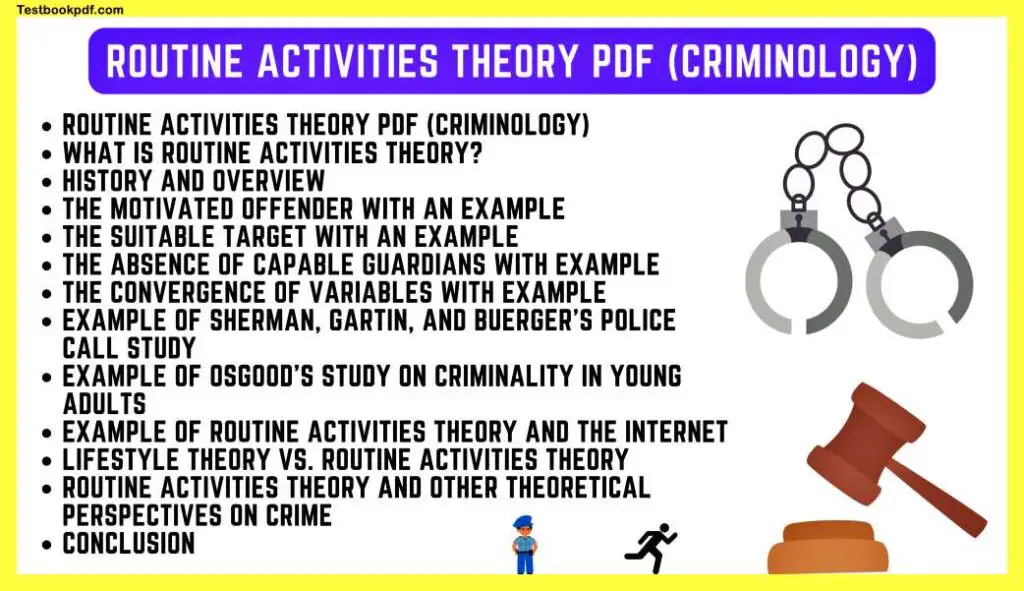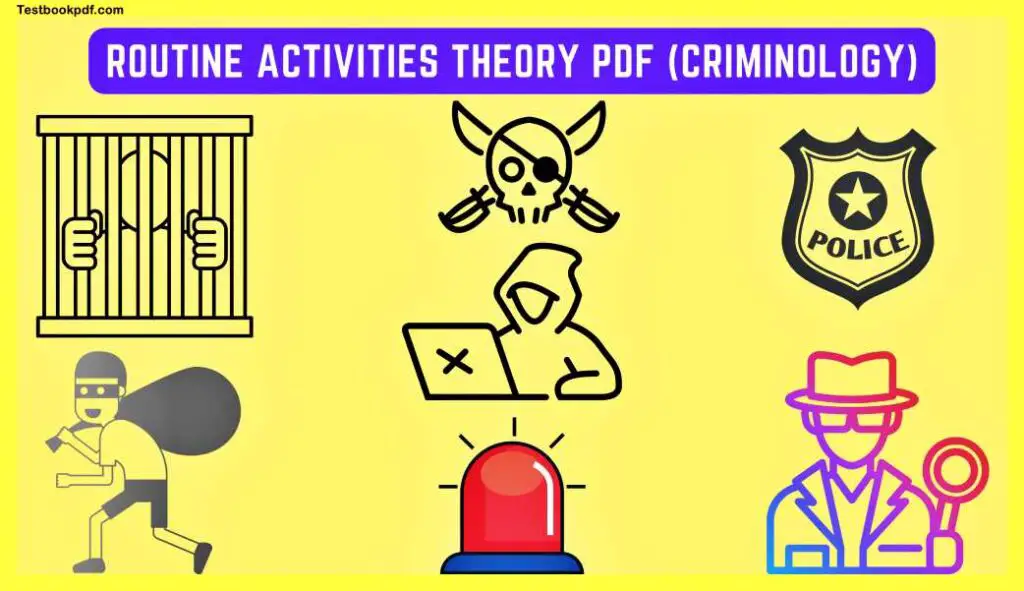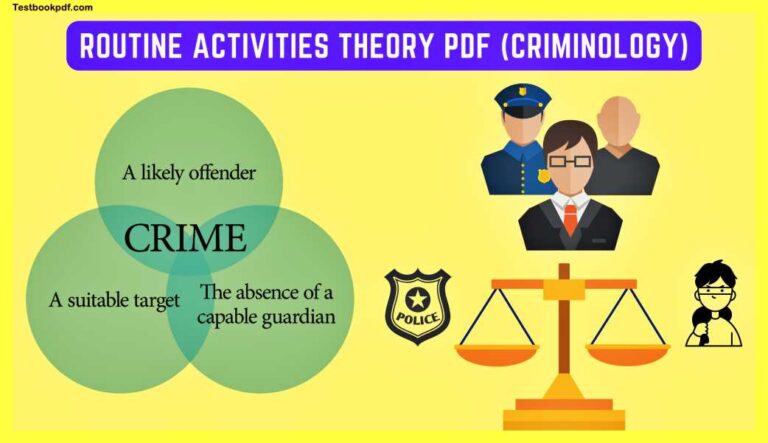Routine Activities Theory Pdf (Criminology)
Today in this article we will discuss the Routine Activities Theory Pdf (Criminology) with Images and Examples, you can download this page as a pdf just go to the end of this article. So let’s start.
What is Routine Activities Theory?
Routine Activities Theory is a sociological theory that explains how crime occurs as a result of the convergence of three elements: a motivated offender, a suitable target, and the absence of a capable guardian.
According to this theory, crime is more likely to occur when these three elements come together in a particular place or at a particular time. For example, if a motivated offender (someone who wants to commit a crime) comes across a suitable target (something that is valuable and easy to take) that is not protected by a capable guardian (such as a security guard or a locked door), the offender is more likely to commit a crime.
Routine Activities Theory has been widely used to understand and predict patterns of crime and to inform crime prevention strategies. Some famous examples of research that has applied Routine Activities Theory include:
- Sherman, Gartin, and Buerger’s police call study examined the relationship between police calls for service and crime rates in a mid-sized city in the United States.
- Osgood’s study on criminality in young adults examined the factors that contribute to criminal behavior in young adults.
- Routine activities theory and the internet, which has been used to understand and prevent cyber crimes such as hacking and identity theft.
History and Overview
Routine Activities Theory was developed by Marcus Felson and Lawrence E. Cohen in 1979. It was initially developed as a way to explain why some areas experienced higher levels of crime than others, despite having similar levels of poverty and other socio-economic characteristics.
Felson and Cohen argued that crime is not evenly distributed across all areas, but rather is concentrated in certain locations and at certain times. They proposed that this is due to the convergence of the three elements mentioned above: motivated offenders, suitable targets, and the absence of capable guardians.
Since its inception, Routine Activities Theory has been widely used in the field of criminology to understand and predict patterns of crime and to inform crime prevention strategies. It has also been applied to a variety of different types of crime, including property crime, violent crime, and white-collar crime.
One of the key contributions of Routine Activities Theory is that it emphasizes the role of the environment in shaping criminal behavior, rather than focusing solely on the characteristics of the offender. This has led to a shift in crime prevention strategies towards a more place-based approach, which aims to design and manage the physical environment in ways that make it less conducive to crime.
For example, the use of Routine Activities Theory has informed the design of public spaces such as shopping malls and parks to make them less conducive to crime. This might involve increasing the presence of capable guardians (such as security guards or security cameras), designing the layout of the space to increase visibility and reduce hiding places, and providing a range of activities and amenities that attract a diverse, supervised crowd. By designing the physical environment in these ways, it is possible to disrupt the convergence of the three elements necessary for a crime to occur, according to Routine Activities Theory.
The motivated offender with an Example
According to Routine Activities Theory, the motivated offender is one of the three elements that must be present in order for a crime to occur. A motivated offender is someone who has the desire or intention to commit a crime. This can be motivated by a variety of factors, including financial gain, personal gain, revenge, or simply the thrill of committing a crime.
For example, consider a scenario in which a motivated offender is interested in committing a robbery. They might search for a suitable target, such as a convenience store that is open late and has a large amount of cash on hand, but that is not well protected by a capable guardian (such as a security guard or security cameras). In this situation, the convergence of the three elements (the motivated offender, the suitable target, and the absence of a capable guardian) increases the likelihood that the motivated offender will commit the crime of robbery.
It is important to note that Routine Activities Theory does not suggest that all motivated offenders will necessarily go on to commit a crime. Rather, it is the convergence of all three elements (the motivated offender, the suitable target, and the absence of a capable guardian) that increases the likelihood of a crime occurring.

The suitable target with an Example
According to Routine Activities Theory, the suitable target is one of the three elements that must be present in order for a crime to occur. A suitable target is something that is valuable and easy to take, and that is not well protected.
Examples of suitable targets might include an unlocked car with valuable items inside, an unoccupied house with valuable possessions inside, or a person walking alone in an isolated area with valuable items such as a purse or wallet.
In order to prevent crime, it is important to make potential targets less attractive or more difficult to access. This can be done through a variety of means, including securing valuable items, increasing the visibility of potential targets, and designing the physical environment in ways that make it more difficult for offenders to access or escape.
For example, a business might install security cameras and alarms to deter thieves, or a homeowner might install deadbolts and security lighting to make their home less vulnerable to break-ins. By making potential targets less attractive or more difficult to access, it is possible to disrupt the convergence of the three elements necessary for a crime to occur, according to Routine Activities Theory.
The absence of capable guardians with Example
According to Routine Activities Theory, the absence of a capable guardian is one of the three elements that must be present in order for a crime to occur. A capable guardian is someone or something that can effectively protect a potential target from being victimized by a motivated offender.
Examples of capable guardians might include security guards, police officers, or locked doors. When motivated offender comes across a suitable target that is protected by a capable guardian, they are less likely to commit a crime.
In order to prevent crime, it is important to increase the presence of capable guardians in areas where crime is more likely to occur. This can be done through a variety of means, including hiring security guards, increasing police patrols, and installing security systems such as cameras and alarms.
For example, a mall might hire security guards to patrol the parking lot and entrances, or a neighborhood might start a neighborhood watch program to increase the presence of capable guardians in the area. By increasing the presence of capable guardians, it is possible to disrupt the convergence of the three elements necessary for a crime to occur, according to Routine Activities Theory.
The convergence of variables with Example
According to Routine Activities Theory, crime is more likely to occur when the three elements of a motivated offender, a suitable target, and the absence of a capable guardian come together in a particular place or at a particular time.
For example, consider a scenario in which a motivated offender (someone who wants to commit a crime) comes across an unlocked car with valuable items inside that is parked in a poorly lit, unpatrolled parking lot. In this situation, the motivated offender has encountered a suitable target (the car and its valuable contents) that is not protected by a capable guardian (such as a security guard or a locked garage). This convergence of the three elements increases the likelihood that the motivated offender will commit a crime, such as stealing valuable items from the car.
On the other hand, if the same car were parked in a well-lit, patrolled parking lot with security cameras, the motivated offender would be less likely to commit a crime, because the presence of a capable guardian (the security cameras and patrols) would disrupt the convergence of the three elements.
In order to prevent crime, it is important to disrupt the convergence of the three elements by removing the motivated offender from the area, making the target less attractive or more difficult to access, or increasing the presence of capable guardians.
Example of Sherman, Gartin, and Buerger’s police call study
Sherman, Gartin, and Buerger’s police call study was a research study that used Routine Activities Theory to examine the relationship between police calls for service and crime rates in a mid-sized city in the United States.
The study found that crime was more likely to occur in areas with higher levels of “opportunity” for crime, as defined by the convergence of the three elements identified by Routine Activities Theory (a motivated offender, a suitable target, and the absence of a capable guardian).
For example, the study found that areas with a higher concentration of businesses and other targets for property crime (such as retail stores or ATM machines) had higher rates of property crime. Similarly, areas with a higher concentration of people (such as bars or restaurants) had higher rates of violent crime.
The study also found that areas with higher levels of police patrols and other capable guardians (such as security guards or security cameras) had lower rates of crime. This supports the idea that increasing the presence of capable guardians can disrupt the convergence of the three elements necessary for a crime to occur, according to Routine Activities Theory.
So, the study demonstrated the utility of Routine Activities Theory in understanding and predicting patterns of crime and informing crime prevention strategies.
Example of Osgood’s study on criminality in young adults
Osgood’s study on criminality in young adults was a research study that used Routine Activities Theory to examine the factors that contribute to criminal behavior in young adults.
The study found that young adults who engaged in criminal behavior were more likely to have a combination of personal, social, and environmental risk factors that increased their likelihood of committing a crime. These risk factors included personal characteristics such as low self-control, social factors such as peer involvement in criminal activity, and environmental factors such as living in a high-crime neighborhood.
The study also found that young adults who engaged in criminal behavior were more likely to encounter opportunities for crime, as defined by the convergence of the three elements identified by Routine Activities Theory (a motivated offender, a suitable target, and the absence of a capable guardian).
For example, young adults who lived in high-crime neighborhoods were more likely to encounter motivated offenders and suitable targets and were also less likely to have capable guardians (such as police patrols or security cameras) to protect them from victimization. This increased their likelihood of becoming involved in criminal activity.
So, the study demonstrated the utility of Routine Activities Theory in understanding and predicting patterns of criminal behavior in young adults and informing interventions to reduce criminal behavior.

Example of Routine activities theory and the internet
Routine Activities Theory has also been applied to the study of crime on the internet, as the convergence of the three elements identified by the theory (a motivated offender, a suitable target, and the absence of a capable guardian) can also occur online.
For example, a motivated offender who is interested in committing cyber crimes (such as hacking or identity theft) may search for suitable targets (such as unsecured personal information or vulnerable computer systems) that are not protected by capable guardians (such as strong passwords or security software).
To prevent cybercrime, it is important to disrupt the convergence of these three elements by making potential targets less attractive or more difficult to access, increasing the presence of capable guardians (such as through the use of security software and strong passwords), and reducing the number of motivated offenders by increasing the perceived risk or consequences of committing cyber crimes.
For example, individuals and organizations can protect themselves from cybercrime by using strong, unique passwords, installing and regularly updating security software, and being cautious about the information they share online. By taking these precautions, it is possible to reduce the likelihood of cybercrime occurring, according to Routine Activities Theory.
Lifestyle Theory vs. Routine Activities Theory
Lifestyle Theory and Routine Activities Theory are two sociological theories that are used to understand and predict patterns of crime and inform crime prevention strategies. While both theories emphasize the role of the environment in shaping criminal behavior, they differ in their focus and key explanatory variables.
Lifestyle Theory, developed by Ronald V. Clarke and John E. Eck, suggests that crime is more likely to occur when an individual’s daily routine brings them into contact with potential criminal opportunities. According to this theory, an individual’s lifestyle, or the activities and patterns of behavior that make up their daily routine, can increase their risk of involvement in the crime.
Routine Activities Theory, on the other hand, suggests that crime is more likely to occur when the three elements of a motivated offender, a suitable target, and the absence of a capable guardian converge in a particular place or at a particular time. This theory emphasizes the role of the environment in shaping criminal behavior, rather than focusing solely on the characteristics of the offender.
So, both Lifestyle Theory and Routine Activities Theory offer useful insights into the factors that contribute to crime and can inform crime prevention strategies. However, they differ in their focus and explanatory variables and may be more or less applicable in different contexts.
Routine activities theory and other theoretical perspectives on crime
Routine Activities Theory is one of many sociological theories that have been developed to understand and explain patterns of crime and inform crime prevention strategies. Other theoretical perspectives on crime include:
- Biological theories suggest that criminal behavior is influenced by genetic or physiological factors.
- Psychological theories suggest that criminal behavior is influenced by individual characteristics such as personality or cognitive processes.
- Social learning theories suggest that criminal behavior is learned through observation and reinforcement.
- Social structure theories suggest that criminal behavior is influenced by the social, economic, and cultural conditions in which an individual lives.
- Cultural theories suggest that criminal behavior is influenced by the values, beliefs, and customs of a particular culture or subculture.
Each of these theoretical perspectives offers a different perspective on the causes of crime and can inform different approaches to crime prevention. Routine Activities Theory, in particular, emphasizes the role of the environment in shaping criminal behavior and suggests that crime can be prevented by disrupting the convergence of the three elements necessary for a crime to occur (a motivated offender, a suitable target, and the absence of a capable guardian).
How does routine activities theory explain cybercrime?
Routine Activities Theory can be applied to the study of cybercrime, as the convergence of the three elements identified by the theory (a motivated offender, a suitable target, and the absence of a capable guardian) can also occur online.
For example, a motivated offender who is interested in committing cyber crimes (such as hacking or identity theft) may search for suitable targets (such as unsecured personal information or vulnerable computer systems) that are not protected by capable guardians (such as strong passwords or security software). In this case, the convergence of the three elements increases the likelihood that the motivated offender will commit a cybercrime.
To prevent cybercrime, it is important to disrupt the convergence of these three elements by making potential targets less attractive or more difficult to access, increasing the presence of capable guardians (such as through the use of security software and strong passwords), and reducing the number of motivated offenders by increasing the perceived risk or consequences of committing cyber crimes.
For example, individuals and organizations can protect themselves from cybercrime by using strong, unique passwords, installing and regularly updating security software, and being cautious about the information they share online. By taking these precautions, it is possible to reduce the likelihood of cybercrime occurring, according to Routine Activities Theory.
Conclusion
Routine Activities Theory has been widely used in the field of criminology to understand and predict patterns of crime and to inform crime prevention strategies. It emphasizes the role of the environment in shaping criminal behavior and suggests that crime can be prevented by disrupting the convergence of the three elements necessary for a crime to occur.



